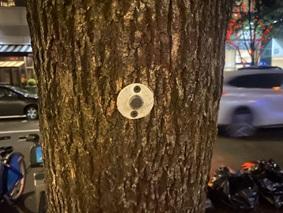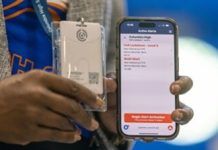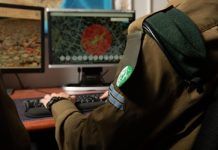New York City’s security companies are embracing a new tool in their mission to protect private property: public trees. In recent months, security contractors have quietly drilled electronic “tokens” into the trunks of city street trees. Guards scan the trackers with their phones, providing real-time data on the status of their patrols.
Security providers touted the devices as an effective accountability tool — a way to assure clients they are keeping a close eye on their assets. But as the arboreal checkpoints gain popularity, both tree lovers and surveillance sceptics are raising concerns.
“They’re totally wounding the tree,” said Justin Rawson, an arborist in Brooklyn. “Even if they can withstand it, no one should be doing this to city trees.” A spokesperson for the city’s parks department confirmed they were aware of the trackers, which violate the city’s law against defacing trees. But that hasn’t stopped private companies, some of whom are contracted by the city, from taking advantage of the urban forestry. And it appears unlikely the city will issue violations, according to the parks department.
“Sometimes in Manhattan, there’s no place to put anything,” said Evans Imafidon, the CEO of Kings Security Service, a Bronx-based contractor that provides security to both luxury apartments and city buildings. The firm has installed half-dollar-sized badges on at least 10 trees – gingkos, honey locusts, and pin oaks among them – that line the streets surrounding a middle school construction site in Alphabet City.
“It’s good exercise,” said the site’s guard, Joseph Taylor, as he stepped over piles of trash and rat-infested tree pits to reach the checkpoints. His main responsibilities, he said, were keeping trespassers out of the school and deterring homeless people from lying on the sidewalks.
Roughly a mile west, the Bowery Residents’ Committee, a homeless services provider, has taken a similar approach to sidewalk security. Over the summer, trees on the four blocks surrounding the building received white buttons, according to employees who said they are expected to scan them on nightly patrols.
Muzzy Rosenblatt, the executive director of the BRC, said the security posts were part of the shelter’s “good neighbour program,” which aims to assure nearby residents that the provider is keeping a close watch over the street. He said it was a mistake to use the surface of trees for the program.
“We’ve been doing this for years, this is just the use of a new technology,” he said. “We’re there encouraging positive behaviour, discouraging negative behaviour, looking out for the welfare of our clients and the community.”








